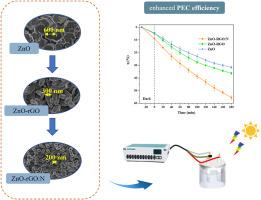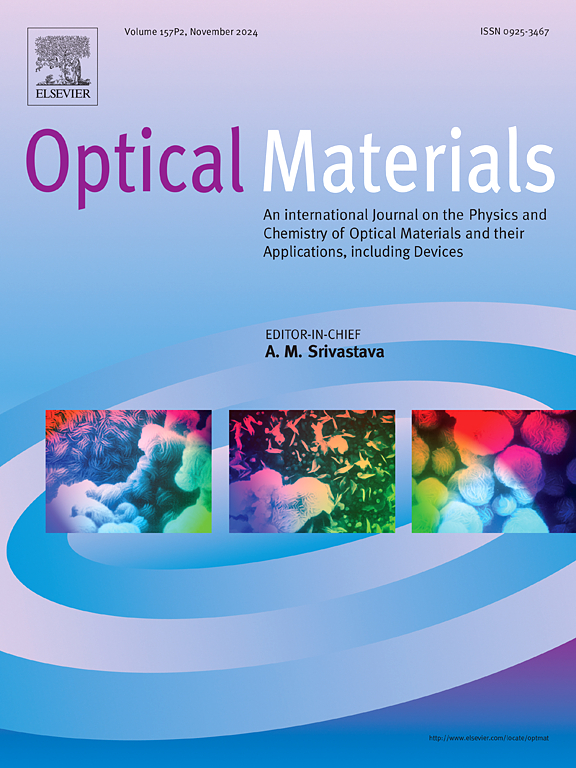Novel electrochemical synthesis of N-doped ZnO–rGO films for the photoelectrocatalytic degradation of antibiotics
IF 3.8
3区 材料科学
Q2 MATERIALS SCIENCE, MULTIDISCIPLINARY
引用次数: 0
Abstract
This study involved the synthesis of modified ZnO materials for photoelectrocatalysis (PEC) by a simple and environmentally friendly electrochemical procedure. The objective was to assess their capacity to photochemically breakdown ofloxacin (OFX) in an aqueous solution. To enhance the PEC performance of pure ZnO, a zinc oxide–reduced graphene oxide (ZnO–rGO) composite was synthesized through an electrochemical co-deposition process without the use of a reducing agent. Subsequently, ZnO–rGO was doped with N (ZnO–rGO:N) to further augment the PEC performance of the photoanode. The surface morphology, microstructure, and optical characteristics of the materials were systematically investigated through X-ray diffraction (XRD), scanning electron microscopy (SEM), X-ray photoelectron spectroscopy (XPS), Raman spectroscopy, and UV–visible spectroscopy. The parameters for synthesizing ZnO–rGO were optimized based on the experimental results” if it can more simply convey your intended meaning. Electrochemical tests demonstrated that N-doping significantly enhanced the photocurrent density of the ZnO–rGO films, which reached 15.14 μA cm−2, representing 1.6- and 1.3-fold enhancements with respect to those of pure ZnO (9.25 μA cm−2) and ZnO–rGO (12.0 μA cm−2), respectively. Additionally, the band gap in ZnO was narrowed from 3.4 to 3.18 eV owing to rGO co-deposition and N-doping. After 180 min of Xe lamp irradiation, with a bias potential of 0.7 V (referenced to Ag/AgCl), ZnO–rGO:N demonstrated an OFX degradation rate of 55.7 %. Thus, the N-doped material exhibited higher PEC performance than either ZnO (31.8 %) or ZnO–rGO (36.3 %), implying its enhanced PEC capabilities. Therefore, the modified ZnO-based photoanode prepared using the straightforward electrochemical deposition method satisfied the objective of this study, which was to enhance its PEC activity while providing a viable foundation for nitrogen doping through electrochemical methods.

用于抗生素光电催化降解的掺杂 N 的 ZnO-rGO 薄膜的新型电化学合成方法
本研究采用简单、环保的电化学方法合成了用于光电催化(PEC)的改性氧化锌材料。目的是评估它们在水溶液中光化学分解氧氟沙星(OFX)的能力。为了提高纯氧化锌的光化学分解性能,研究人员在不使用还原剂的情况下,通过电化学共沉积工艺合成了氧化锌-还原氧化石墨烯(ZnO-rGO)复合材料。随后,ZnO-rGO 掺杂了 N(ZnO-rGO:N),以进一步提高光阳极的 PEC 性能。通过 X 射线衍射 (XRD)、扫描电子显微镜 (SEM)、X 射线光电子能谱 (XPS)、拉曼光谱和紫外可见光谱,系统地研究了材料的表面形貌、微观结构和光学特性。根据实验结果对合成 ZnO-rGO 的参数进行了优化。电化学测试表明,掺杂 N 能显著提高 ZnO-rGO 薄膜的光电流密度,达到 15.14 μA cm-2,与纯 ZnO(9.25 μA cm-2)和 ZnO-rGO (12.0 μA cm-2)相比,分别提高了 1.6 倍和 1.3 倍。此外,由于 rGO 共沉积和 N 掺杂,ZnO 的带隙从 3.4 eV 缩小到 3.18 eV。在偏置电位为 0.7 V(参照 Ag/AgCl)的氙灯辐照 180 分钟后,ZnO-rGO:N 的 OFX 降解率达到 55.7%。因此,掺 N 材料的 PEC 性能高于 ZnO(31.8%)或 ZnO-rGO(36.3%),这意味着它的 PEC 能力得到了增强。因此,采用直接电化学沉积法制备的改性氧化锌光阳极满足了本研究的目标,即在提高其 PEC 活性的同时,为通过电化学方法掺氮提供可行的基础。
本文章由计算机程序翻译,如有差异,请以英文原文为准。
求助全文
约1分钟内获得全文
求助全文
来源期刊

Optical Materials
工程技术-材料科学:综合
CiteScore
6.60
自引率
12.80%
发文量
1265
审稿时长
38 days
期刊介绍:
Optical Materials has an open access mirror journal Optical Materials: X, sharing the same aims and scope, editorial team, submission system and rigorous peer review.
The purpose of Optical Materials is to provide a means of communication and technology transfer between researchers who are interested in materials for potential device applications. The journal publishes original papers and review articles on the design, synthesis, characterisation and applications of optical materials.
OPTICAL MATERIALS focuses on:
• Optical Properties of Material Systems;
• The Materials Aspects of Optical Phenomena;
• The Materials Aspects of Devices and Applications.
Authors can submit separate research elements describing their data to Data in Brief and methods to Methods X.
 求助内容:
求助内容: 应助结果提醒方式:
应助结果提醒方式:


